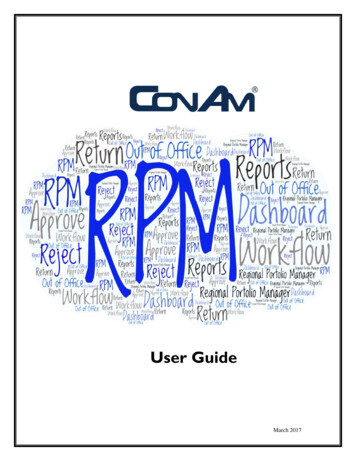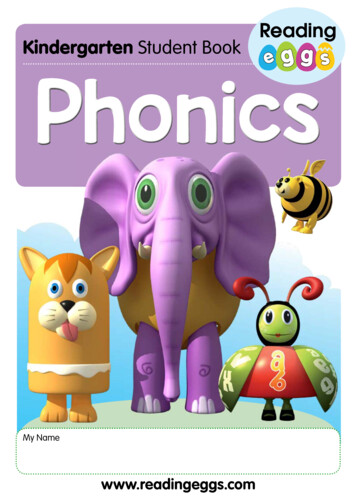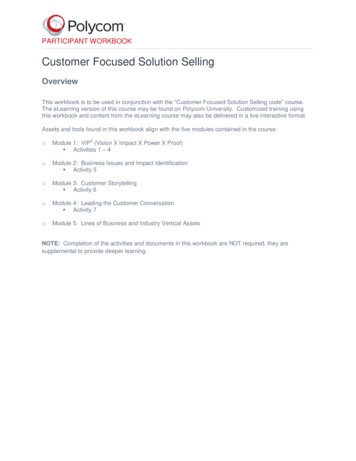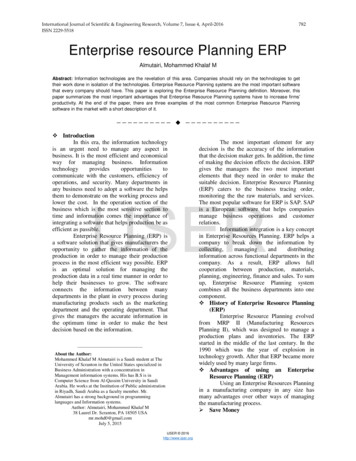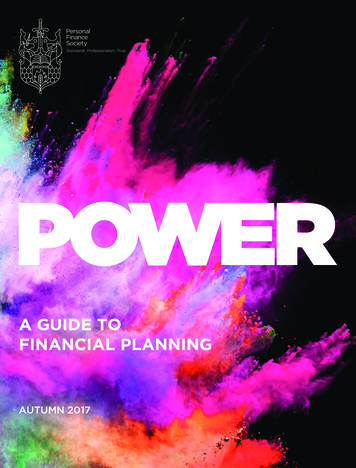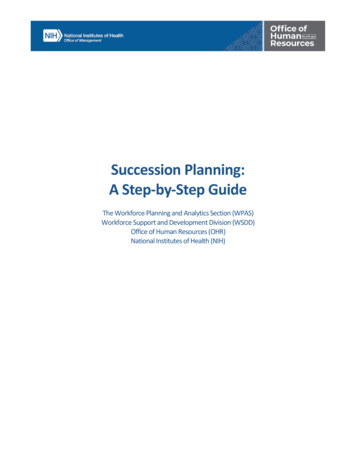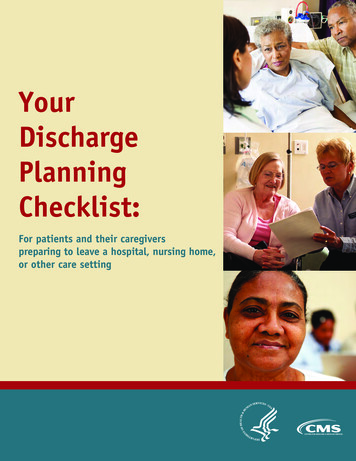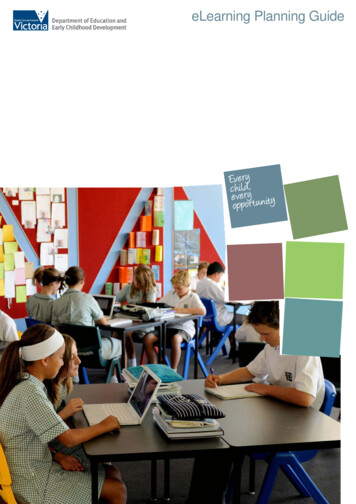
Transcription
eLearning Planning GuideeLearning Planning Guide
Published Student Learning Programs Divisionfor the Department of Education andEarly Childhood DevelopmentMelbourneJanuary 2009 State of Victoria (Department of Educationand Early Childhood Development) 2009The copyright in this document is owned by theState of Victoria (Department of Education and Early Childhood Development), or in the caseof some materials, by third parties (third party materials). No part may be reproduced by anyprocess except in accordance withthe provisions of the Copyright Act 1968, the National Education Access Licence for Schools(NEALS)(see below) or with permission.An educational institution situatedin Australia which is not conductedfor profit, or a body responsiblefor administering such an institution,may copy and communicate thematerials, other than third partymaterials, for the educationalpurposes of the institution.Authorised by the Department of Educationand Early Childhood Development,2 Treasury Place, East Melbourne, Victoria, 3002.ISBN [to be inserted if required]This document is also available on the internet /elearning/planning/default.htm2Publication Title
ContentsAbout this guide .3Why plan for eLearning?.4Empowering students to fully engage in a 21st centurylearning environment. .4DEECD initiatives .5Victorian Essential Learning Standards .5School ICT Progression Strategy .5ePotential: ICT Capabilities Resource .5The Ultranet .6Australian Government initiatives .7Digital Education Revolution .7MCEETYA Framework .7eLearning Planning & the Effective Schools Model .8Effective Schools Model: focus on eLearning .8eLearning Planning .9Developing your eLearning Plan . 10eLearning Vision . 10The eLearning Planning Matrix . 11Matrix overview . 11Using the eLearning Planning Matrix to develop theeLearning Plan . 13eLearning Planning Template . 14Unpacking the elements . 15eLearning Leadership . 15Learning, Teaching, Assessment and Reporting . 17ICT Professional Learning . 20Learning Places and Spaces . 23Learning Communities . 25Evaluation, Review and Management . 26IT infrastructure and technical support: . 27Supporting the School ICT Progression Strategy (SIPS) . 27eLearning Planning Guide, 20091
eLearning Planning Guide, 20092
About this guideThis guide is designed tosupport Victorian Governmentschools to make eLearningplanning an integral part of theirSchool Strategic Plan andAnnual Implementation Plan. Itwill help each school develop aneLearning Plan that will improveoutcomes through theintegration of information andcommunication technologies(ICT) across all aspects ofschool activity.eLearning Planning Guide, 2009eLearning includes the exploration anduse of diverse ICT strategies and toolsto expand teaching and learningpossibilities in ways that lead toimproved student learning outcomes.There needs to be cohesion across allelements of eLearning planning toensure that infrastructure andresources are used to reconceptualiseteaching and learning, in order tomaximise the benefits of the digital age.Successful eLearning implementationoccurs only when eLearning is anintegral part of a school’s vision forlearning.3
Why plan for eLearning?‘21st century education integratestechnologies, engaging students inways not previously possible, creatingnew learning and teachingpossibilities, enhancing achievementand extending interactions with localand global communities.’(MCEETYA ICT in Schools Taskforce,‘Contemporary Learning’ document inLearning in an Online World, 2005)21st century learning demands newpedagogical and technologicalapproaches to using ICT for learning. Itis the responsibility of teachers andschool leaders to prepare students forthe demands of an ever-changingworld, through facilitating learning in atechnology-rich environment, wherestudents and teachers don’t just learnabout technology, they use it to achievepowerful learning and teaching andimprove student learning outcomes.Empowering students tofully engage in a 21stcentury learningenvironment.Today’s students think, learn and live inan increasingly online world. Newtechnologies and virtual environmentsallow important parts of their personaland social life to be digitised, sharedand linked to global communities.Students may have more access totechnology at home than at school.Outside of school they may regularlycontribute to online forums, interactwith and seek help from peers and findinnovative methods of solvingproblems, managing their time andexpressing themselves. Often thishappens all at once using multipleapplications, devices and interfaces.A transformative school recognises andfurther develops these capabilities. Itrevises its curriculum and learningprograms to include opportunities forstudents to work autonomously andconcurrently in a dynamic andchallenging environment. There areopportunities for students to use theirown ICT devices to tap into powerfuland personal learning networks.Students have access to moreinformation and communication toolsthan ever before in human history.Such access calls for a new literacy:digital/ICT literacy. This requiresstudents to be aware, wary anddiscriminating. They need to beempowered users who make informedchoices about the information theyseek, the products they want to createand the tools they use.The challenge for schools is to createengaging and supportive learningenvironments and opportunities thatstimulate, extend and deepen studentlearning, and incorporate seamless useof the technologies students use soubiquitously in their daily lives.A school’s eLearning Plan needs totake into account the emergingdigital/ICT literacies of today’s andtomorrow’s students, and to developappropriate and targeted strategies tosupport improved learning andteaching.Digitally literate learners: want to be connected are discriminating are empowered and criticallyliterate are information seekers andnavigators understand they are part of aglobal community and that learningis unrestricted by classroom walls are demanding of content,teaching quality and access toresources think, analyse and constructknowledge constantly communicate virtually.1(dk2 , 2008)1eLearning Planning Guide, 2009http://www.dk2.com.au4
DEECD initiativesA number of Victorian Governmentinitiatives create a new ICT landscapefor schools. eLearning planningsupports these by bringing into focusthe role of ICT. It complements theDepartment of Education and EarlyChildhood Development’s (DEECD)School Strategic PlanningGuidelines – 20081 and feeds into theSchool ICT Progression Strategy2(SIPS) The eLearning planningframework parallels the EffectiveSchools Model and supports schools asthey prepare for implementation of theUltranet.The role of eLearning planning in someof these initiatives is elaborated onhere.Victorian EssentialLearning StandardsePotential: ICTCapabilities ResourceThe Victorian Essential LearningStandards (VELS) has identified ICT asa key interdisciplinary domain that‘focuses on providing students with thetools to transform their learning and toenrich their learning environment’(VELS, Victorian Curriculum andAssessment Authority [VCAA])3.The ePotential ICT CapabilitiesResource4 provides schools with anICT Capabilities Framework, an onlinesurvey, planning tools and a bank ofresources to support the developmentof teachers’ ICT capabilities withinlearning and teaching contexts.eLearning planning supports the impactof the ICT domain of VELS across allareas of the curriculum.It enables a cohesive, whole schoolapproach to planning for the integrationof ICT into learning and teaching. Thisempowers teachers and students totransform how learning occurs and toenrich learning environments inschools, improving student learningoutcomes.ePotential supports the eLearning Planby providing indicative benchmark datathat informs the professional learningneeds of staff. Analysing ePotentialsurvey results can assist teachers toidentify ICT professional learning goals.The results can also indicateinformation about the use or non-use ofICT resources.School ICT ProgressionStrategyThe School ICT Progression Strategy(SIPS) initiative is an integral part of theTechnical Support to Schools Program(TSSP) specifically designed to provideenhanced support in the area of ICTinfrastructure to school leadershipteams, ICT staff and technicians.SIPS will deliver a standardisedapproach to ICT infrastructure for allschools and will support the roll-out ofthe Ultranet. SIPS recommends aneLearning Plan as a fundamental basisfor infrastructure planning in eachschool, including the development of aSchool ICT Inventory and a School ICTInfrastructure Roadmap and SchoolStrategic ic/account/operate/SSP earning Planning Guide, 2009http://epotential.education.vic.gov.au5
DEECD initiatives (Continued)The UltranetThe Ultranet1 is a student-centredelectronic learning environment thatsupports high-quality learning andteaching, connects students, teachersand parents and enables efficientknowledge transfer. It will establish aschools environment for the future thatimproves the educational outcomes ofall Victorians.The Ultranet enables DEECD to bettersupport Victorian Government schoolsand enhance active partnerships withparents and help to improve studentlearning, support the work of teachers.Key benefits of the Ultranet to thecommunity: establish a school environment forthe future improve the educational outcomesof Victorians reduce the administrative burdenon teachers and school leaders reduce the future cost of education improve educational opportunitiesfor regional, rural and remoteVictorians.The Ultranet will be available for allVictorian government schools in Term 32010.Objectives of the Ultranet: improve responsiveness toindividual learning needs provide better information toparents, the school system andGovernment improve efficiency of the learningenvironment and schooladministration adopt an enterprise approach tointranet development exploit previous ICT ement/ultranet/eLearning Planning Guide, 20096
Australian Government initiativesDigital EducationRevolutionThe emphasis on 21st century learningis reflected in recent CommonwealthGovernment initiatives relating totechnology in education.‘The Digital Education Revolution is amajor part of the CommonwealthGovernment's Education Revolution. 1 billion is being committed over fouryears with the aim to contributesustainable and meaningful change toteaching and learning in Australianschools that will prepare students forfurther education, training, jobs of thefuture and to live and work in a digitalworld.’(http://wps.pearsoned.com.au/au hss finger translearn 1/56/14383/3682213.cw/-/3682229/index.html)One aspect of the Digital EducationRevolution is the National SecondarySchools Computer Fund (NSSCF).Schools seeking funding for thisinitiative are asked to adhere to StateGovernment education jurisdictionalprocurement guidelines, which includeproviding evidence of either an existingor a developing ICT Strategic Plan. TheeLearning Planning Guide supportsschools to create and update such aplan. It provides a sound basis fromwhich schools can articulate clear andworkable goals, and also enablesschools to take advantage ofopportunities available through theAustralian Government’s DigitalEducation Revolution initiative.MCEETYA FrameworkThe DEECD eLearning planningframework is aligned to Digitaleducation – Making change happen isa framework for strategic planning andreflection published in 2008 by theCurriculum Corporation for theMinisterial Council on Education,Employment, Training and YouthAffairs (MCEETYA). It details the ICTbased characteristics and attributes ofdeveloping, accomplished and site/users/root/public/Digital education full.pdfeLearning Planning Guide, 20097
eLearning Planning & the EffectiveSchools ModelThe Effective Schools Model outlinesthe characteristics that help make aschool effective. Victorian schools canuse this model to evaluate and guidetheir improvement.Effective Schools Model:focus on eLearningThe diagram shows the relationshipbetween the Effective Schools Modeland eLearning planning, highlightingthe ways in which ICT enablesimproved practice.‘To achieve the vision of the Blueprintfor Government Schools, the VictorianGovernment must build an excellentgovernment school system, rather thana system with some excellentgovernment schools. An excellentschool system is one that is made upof effective schools that arecontinuously improving.’(DEECD Blueprint for GovernmentSchools – Effective School1)Figure 1: Effective Schools ModelProfessional leadershipeLearning leadership builds an eLearning culture, as itstrategically plans for, implements, monitors and evaluates theintegration of ICT for improved learning, teaching andadministration.Stimulating and secure learningenvironmentICT, used effectively, promotesdiverse, flexible, interactive, qualitylearning and teaching within a safeonline environment.Focus on teaching and learningICT is used strategically toimprove learning and teaching,and it is supported by effectiveprofessional learning.Purposeful teachingICT is used to enhance effectiveteacher practice, to engagelearners and to contextualiseteaching to meet the needs ofindividual learners.Learning CommunitiesICT facilitates collaboration withinthe school community, and thegrowth of effective learningcommunities within and beyond theschool.Shared vision and goalsEffective schools have a clear andshared understanding of how ICTcan improve student learningoutcomes, which is reflected in theschool’s vision and goals.AccountabilityICT enhances accountabilityacross the school, improvingcommunication between parents,teachers and students.High expectations of all learnersICT, used effectively, can challenge schools to transformlearning and teaching, enhance learning opportunities andimprove learning outcomes for ons/blueprint1/es/default.htmeLearning Planning Guide, 20098
eLearning PlanningeLearning Planning is integral to theSchool Strategic Plan and will supportall schools to continue to improve theiruse of ICT for learning and teachingFigure 2. Model for developing an eLearning PlaneLearningConsiderationsSchool Accountability andImprovement FrameworkConsider eLearningfocus questionsSelf Evaluation GuidelinesInclude strategiesfor eLearningSchool Strategic PlanInclude milestonesfor eLearningAnnual Implementation Planadd as appendixeLearningDocumentationConsider howeLearning isincluded in wholeschool planningDevelopeLearning PlanAnnualImplementationPlaneLearning VisioneLearning LeadershipLearning,Teaching,Learning, Teaching,Assessmentand& ReportingAssessmentReportingICT Professional LearningLearning Places andSpacesLearning CommunitiesReview and ManagementeLearning Planning ElementsFigure 3. School Strategic Plan ModelSchool StrategicPlanIT Infrastructure and technical support:Supporting the School ICT Progression Strategy (SIPS)ICT NetworkAuditeLearning Planning Guide, 2009ICT RoadmapdevelopmentBuild ICTfoundationExtend ICTbeyondfoundation9
Developing your eLearning PlaneLearning Vision‘A critical factor in the effective use ofICT is the existence of a school-levele-strategy that addresses futuredevelopment and sustainability andincludes some means of monitoringprogress against identified milestones.While innovations often begin within akey stage or subject department, theyrequire a whole school commitment ifthey are to become embedded in thedaily experience of pupils, providingcontinuity and coherence across theyears. While champions can, and oftendo, lead the way, new developmentsneed leadership and strategic planningto ensure sustained changes inpractice.’(The Impact of ICT in Schools: ALandscape Review, Becta, 2007)‘21st century schooling – Innovativenew models of schooling that utilisetechnologies in the redesign oforganizational structures andcurriculum are required. Educationsystems are investing in schools aslearning communities with strongpartnerships between students,teachers, families and the widercommunity . Innovative and effectiveuse of ICT is transforming pedagogies,empowering teachers and support staffto focus on student-centered activeand interactive learning.’(Contemporary Learning: Learning inan Online World, MCEETYA, 2005, p.6)An eLearning vision will provide aneLearning direction for your school. Thevision should describe a desiredoutcome that inspires and energisesyou, and helps create a compellingpicture of your school and community inthe future, how it looks and how ICTenables improvement.An eLearning vision needs to emergefrom your School Strategic Plan, inparticular from the school profile(purpose, values and context) andstrategic intent.Consider the following to help youcreate and modify your visionstatement.How will learning and teachingchange, and how will ICTsupport this change?What type of learningenvironments will you see?How will learning take place?What will your students’expectations of learning be?Make sure that your vision is a clearand succinct statement that is easilyunderstood and owned by all membersof your school community: teachersand non-teaching staff, students andparents.Many schools have alreadyexperienced great improvementsthrough using eLearning. Large-scaleconnectivity and infrastructure projectshave been highly successful innetworking schools and connectingthem to the internet. But, the focus isnow shifting – from broadband,technical architecture and access, tothe appropriate use of technology tosupport pedagogy, school improvementand transformation. Transformation oflearning and teaching requires morethan provision of the tools – it requiresongoing support, professional learning,research, leadership and guidance.What will your students know,value, and be able to do whenthey leave your school?Does your eLearning visionstem from the School StrategicPlan, and does it create apicture of what ICT can enablein your school?Is the eLearning vision a strongand succinct statement that iseasily understood by allmembers of the schoolcommunity?How will your eLearning visionsupport a whole schoolapproach to the use of ICT?(Suggestions from Archdiocese ofCanberra and Goulburn EducationOffice website1, accessed March2008)Sample Vision‘To inspire and empower our school’s learning communityto envision and implement innovative eLearning strategiesand technologies to improve student engagement,experience and achievement.’(Victorian Secondary School)‘ICT will be a fundamental component of teaching and learning,where state of the art technology and professional learning willequip teachers with transformative skills and develop studentsthat are innovative and confident users of ICT in an everchanging digital world.’ (Victorian Primary s/ict/strategic/index.htmeLearning Planning Guide, 200910
The eLearning Planning MatrixThe eLearning Planning Matrix is adetailed framework that enablesschools to identify where they are inrelation to the elements of eLearningpractice. The eLearning PlanningMatrix can assist schools to: identify their current strengths set priorities for improvement plan development strategies.You can use the matrix to identify yourcurrent practice. This can occur at staffor other meetings, with teachers insmall groups, or with a leadership teamor committee.Matrix overviewEach of the five elements is divided intosub-elements that highlight the featuresthat contribute to each element. Thematrix also contains indicators for eachsub-element across the four phases ofdevelopment: Foundation, Emergent,Innovative and Transformative.Figure 4. Phase progression of the eLearning Planning ginning theeLearning journey.Established practicesand resourcessupport eLearningimplementation.eLearninginnovation isembedded in theschool culture.eLearning transformslearning and teachingand is evidentthrough wider schoolchange.The eLearning Planning Matrixdescribes four phases of developmentacross five eLearning elements.FoundationeLearning Planning Guide, 2009EmergentTransformative11
Table 1. Elements of the eLearning Planning MatrixElementsSub-elementseLearning Leadership refers to the ways in which school leadershipestablished the ICT vision for the school and supports all aspects ofimplementation and change management. Schools develop an eLearning Planthat is linked to a shared eLearning vision and school priorities. They distribute and shareresponsibility for leading eLearning, secure the school community’s commitment to theeLearning vision and facilitate all aspects of ICT implementation so that it supportsindividual, team and whole school improvement across the school. eLearning leadershipencompasses the way schools use the whole of school ePotential ICT Capabilities Surveyresults and other performance data, including student learning outcomes, to inform theeLearning Plan.Learning, Teaching, Assessment and Reporting refers to how schoolslead, enable and support the use of ICT to transform learning and teaching,extending learning opportunities and improving learning outcomes. It refersto curriculum leadership that supports teachers to recognise and integrate a variety of richuses of ICT in curriculum planning and delivery that is underpinned by statewide studentlearning initiatives. It includes how schools use ICT for improved, more timely and relevantassessment, collecting, communicating and collating student assessment data to informcurriculum design and to report on student progress. It includes how schools use digitalenvironments to provide access to digital resources for improved curriculum planning andhow schools use ICT to deliver curriculum, extending and differentiating student learningopportunities and supporting students to manage and direct their own learning. Schoolsneed to build a culture of ethical, safe and responsible use of ICT. eLearning Leadership Curriculum Planning Curriculum Delivery Applying Student ICT Capabilities ICT Safe and Ethical Behaviours Assessment and Reporting Reporting to Parents Teacher ICT Capabilities Learning and Teaching Support and Cultural Change Access Physical Layout ICT-Enabled LearningCommunitiesICT Professional Learning refers to how schools plan, implement andevaluate effective ICT professional learning that contributes to improvedteacher ICT capabilities. Schools develop structures and conditions to supportteachers to improve their ICT capabilities, to integrate ICT into learning and teachingeffectively and support teachers through the process of change. It refers to how schoolsdevelop collaborative, reflective, inquiry-based ICT professional learning models andcultures aligned to the school’s vision and goals. Schools plan and implement effectiveprofessional learning focused on and embedded in teachers’ ICT practice.It is underpinned by whole school performance data, especially by the ePotential TeacherICT Capabilities Survey, which helps identify ICT professional learning needs.Learning Places and Spaces refers to how schools design, maintain andupdate IT infrastructure, learning places, spaces and resources, tomaximise learning opportunities. The learning environments support the diverseand changing needs of learners, while responding to new and emerging technologies thatenhance learning.It refers to the provision of eLearning in safe and secure, learner centered, flexible learningspaces and connected digital environments, including virtual learning environments thatallow learners to have access to learning resources and support when they are not atschool.It is concerned with equitable learner access to ICT, and with enabling the seamlessintegration of ICT into effective learning and teaching.In addition, it refers to how schools plan for and resource the changing ICT needs of thewhole school community, including support for learners through more efficient and effectiveadministration and student information processes.Learning Communities refers to how schools use ICT to extend learningbeyond the school, and support and connect students, staff and families tolocal and global learning communities. Schools can use ICT and virtualenvironments to enable communication, interaction and collaboration focused onpurposeful learning among learners, teachers, experts, and other local and global learningcommunities, and how schools develop collaborative cultures and protocols, so thatlearners can operate effectively in connected digital environments in the wider schoolcommunity and beyond.It also refers to the way ICT is used to engage learners in authentic learning activities thatconnect with knowledge networks, partnerships and real-world communities of practicebeyond schools, enriching learning environments and improving learner outcomes.eLearning Planning Guide, 200912
Using the eLearning Planning Matrix to develop theeLearning PlanUse the eLearning Planning Matrix toidentify current strengths, to setpriorities for improvement and to plancoordinated development strategies.Figure 5. Steps to developing aneLearning Plan1. Identify your eLearningvision.What is the focus of eLearning in yourschool? How does this relate to yourschool’s goals as described in yourannual implementation plan’s strategicintent?2. Highlight your currentpractice1.Identify thevision4. Use the eLearning PlanningTemplate to help you identifythe strategies/actions youwant to focus on.5. Complete the eLearning Plan6. Evaluation, review andmanagement7. IT infrastructure and technicalsupport: SIPSEvery phase of each sub-element hasindicators. For every sub-element,highlight the indicators that bestdescribe your current practice. This willassist you to get a clear picture ofwhere your school is currently, and itwill also help you choose new targetsfor improvement. Your school mayneed to highlight a range of indicatorsacross two or three phases toadequately describe your currentpractice.2.Highlight currentpractice withinmatrix3.Analyse matrixand set priorities4.Develop keystrategies3. Analyse and set priorities.5.Completeimplementation plan6.Evaluation,review andmanagement7.IT infrastructure andtechnical support: SIPSUse the completed matrix to pinpointand prioritise sub-elements you wouldlike to target with specific strategies.Ideally this analysis and prioritisationshould be done as a consultative,iterative process involving teachers andother key stakeholders. Targeted subelements should be selected to alignwith your eLearning vision.ElementSub-elementIndicators forEmergent phaseeLearning Planning Guide, 200913
eLearning Planning TemplateThe eLearning Planning Template isused in conjunction with the eLearningPlanning Matrix to outline existing andtarget practice, what you need to do,how you will do it, who will beresponsible and when it will be done.School eLearning Vision:Actions – What?Identify/revise an eLearning vision.What specific actions/activities will youundertake?Elements:The aspects of eLearning planning.Resources and budge – How?Sub-elements:What resources and budget will berequired?Sub-elements to consider.Responsibilities – Who?Current practice:Review the eLearning Planning Matrix.Use the indicators to identify theschool’s current practice for each of thesub-elements highlighted. You can cutand paste your chosen indicatordirectly from the matrix into this field.Target practice:Review the eLearning Planning Matrix.Use the indicators to identify theschool’s target practice (desiredoutcomes) for each of the subelements highlighted. You can cut andpaste your chosen indicators directlyfrom the next relevant phase of thematrix into this field.Who will be responsible forimplementing, facilitating and/ormonitoring each of the actionsidentified?Timeline – When?What are the estimated timelines forachieving your actions? Thesetimelines need to be achievable, butalso monitored and modified duringimplementation, if necessary.Success measure:How will you know you have beensuccessful? What will be indicators ofsuccess?Table 2: Sample of eLearning PlanningSchool eLearning AssessmentandRepor
eLearning Planning Guide, 2009 6. DEECD initiatives (Continued) The . on teachers and school leaders. The Ultranet Ultranet 1 is a student-centred electronic learning environment that supports high-quality learning and teaching, connects students, teachers and parents and
